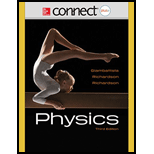
Concept explainers
(a)
The oscillation frequency of the pendulum.
(a)
Answer to Problem 98P
The oscillation frequency is
Explanation of Solution
Mass of object is
Write the equation for the frequency of Foucault pendulum.
Here, the frequency of pendulum is
Conclusion:
Substitute
Therefore, the oscillation frequency is
(b)
The maximum speed of the pendulum.
(b)
Answer to Problem 98P
The maximum speed is
Explanation of Solution
Mass of object is
Write the relation between
Here,
Write the equation for
Refer the diagram shown below. Write the relation between

Here,
Rewrite equation (I) by substituting equations (II) and (III).
Conclusion:
Substitute
Therefore, the maximum speed is
(c)
The maximum tension in the wire.
(c)
Answer to Problem 98P
The maximum tension is
Explanation of Solution
Mass of object is
The free body diagram of object is shown below.

Write the Newton’s second law to find the net force.
Here,
Rewrite the above equation in terms of
Conclusion:
Substitute
Therefore, the maximum tension is
(d)
The fundamental frequency of standing wave at the time of maximum tension.
(d)
Answer to Problem 98P
The fundamental frequency is
Explanation of Solution
Mass of object is
Write the equation for the fundamental frequency of wave.
Here,
Write the equation for
Here,
Rewrite the equation for
Conclusion:
Substitute
Therefore, the fundamental frequency is
Want to see more full solutions like this?
Chapter 11 Solutions
Physics - Connect Access (2 Semester)
 College PhysicsPhysicsISBN:9781305952300Author:Raymond A. Serway, Chris VuillePublisher:Cengage Learning
College PhysicsPhysicsISBN:9781305952300Author:Raymond A. Serway, Chris VuillePublisher:Cengage Learning University Physics (14th Edition)PhysicsISBN:9780133969290Author:Hugh D. Young, Roger A. FreedmanPublisher:PEARSON
University Physics (14th Edition)PhysicsISBN:9780133969290Author:Hugh D. Young, Roger A. FreedmanPublisher:PEARSON Introduction To Quantum MechanicsPhysicsISBN:9781107189638Author:Griffiths, David J., Schroeter, Darrell F.Publisher:Cambridge University Press
Introduction To Quantum MechanicsPhysicsISBN:9781107189638Author:Griffiths, David J., Schroeter, Darrell F.Publisher:Cambridge University Press Physics for Scientists and EngineersPhysicsISBN:9781337553278Author:Raymond A. Serway, John W. JewettPublisher:Cengage Learning
Physics for Scientists and EngineersPhysicsISBN:9781337553278Author:Raymond A. Serway, John W. JewettPublisher:Cengage Learning Lecture- Tutorials for Introductory AstronomyPhysicsISBN:9780321820464Author:Edward E. Prather, Tim P. Slater, Jeff P. Adams, Gina BrissendenPublisher:Addison-Wesley
Lecture- Tutorials for Introductory AstronomyPhysicsISBN:9780321820464Author:Edward E. Prather, Tim P. Slater, Jeff P. Adams, Gina BrissendenPublisher:Addison-Wesley College Physics: A Strategic Approach (4th Editio...PhysicsISBN:9780134609034Author:Randall D. Knight (Professor Emeritus), Brian Jones, Stuart FieldPublisher:PEARSON
College Physics: A Strategic Approach (4th Editio...PhysicsISBN:9780134609034Author:Randall D. Knight (Professor Emeritus), Brian Jones, Stuart FieldPublisher:PEARSON





